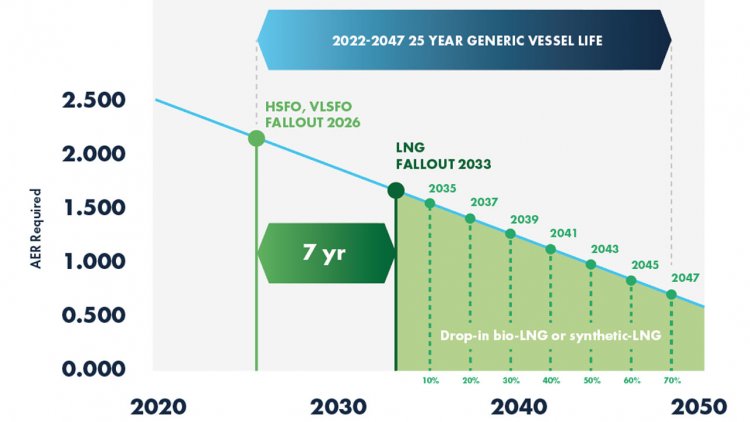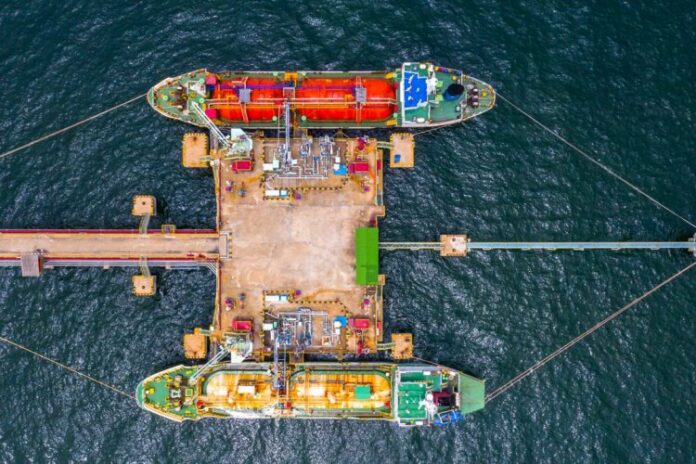New analysis from SEA-LNG, the coalition for accelerating LNG as a marine fuel, has determined that for every 10% of bio-LNG dropped in and blended with LNG as a marine fuel, a vessel can achieve two extra years’ compliance with the Annual Efficiency Ratio (AER) curve used to secure preferable funding under the Poseidon Principles. This extends the average seven-year additional competitive advantage for Poseidon Principle loans achieved with LNG alone.
The analysis compares LNG plus bio-LNG from a zero-carbon, sustainable source with conventional vessel fuels such as HFO, VLSFO and MGO. Bio-LNG is fully compatible with existing LNG infrastructure and technologies and increasingly recognised as a sustainable fuel that can be ‘dropped in’ and blended with LNG. Therefore, it represents one of the most viable pathways to decarbonisation currently available to owners.
LNG fuel delivers greenhouse gas (GHG) reductions of up to 21% Well-to-Wake and up to 28% Tank-to-Wake. This means that LNG vessels perform well according to Poseidon Principles’ funding criteria, which were instigated by financial institutions to improve strategic decision-making and shape a better future for the shipping industry and society.
The Poseidon Principles measure progress towards these objectives using an AER scoring. This follows an ever-tightening decarbonisation trajectory index to 2050, requiring a vessel’s aggregate carbon emissions intensity to improve. This measure is intended to align with and incentivise the IMO’s goals of reducing the total annual GHG emissions by at least 50% by 2050.
John Hatley, SEA-LNG investment committee chairman, commented:
“As banks increasingly align with green finance principles, LNG offers benefits for emissions reduction and provides an ‘extended compliance runway’ for Poseidon Principle sustainability linked loans. An investor preserves more favourable financing terms compared to conventional marine fuels such as HSFO, VLSFO, and MGO. The use of bio-LNG as a drop-in fuel may extend this runway even further- an additional two years for every 10% dropped-in. This means lower ship emissions now and a compliance extension that yields long term competitive advantage.”

The recent CE Delft study concludes that bio-LNG is a scalable solution for the maritime sector. Estimated sustainable global supplies potentially exceed the future energy demand of the global shipping fleet. It also showed that bio-LNG will likely be commercially competitive relative to other low- and zero-carbon fuels.
This analysis is supported by a recent report by the IEA on the outlook for biogas and biomethane. The IEA report concludes that feedstocks available for sustainable production of biogas and biomethane are huge, but only a fraction of this potential is used today. For biomethane to realise its potential as a major zero-emissions energy carrier, policies should remove barriers to scaling and create a single, cross-border market for biomethane and bio-LNG. Policy will also play a key role in allocating biomass resources to the hardest to abate sectors such as shipping, heavy goods transportation, and aviation.
Bio-LNG has particular advantages when it is produced from domestic and agricultural waste. The process can capture methane that would otherwise be vented into the atmosphere, resulting in a fuel that is not just zero GHG emissions but has the potential for negative emissions. By assisting with the reprocessing of waste materials, bio-LNG can support the circular economy and help abate yet another global concern; waste management. The potential GHG reduction benefits from capturing and reusing the global economy’s waste streams are significant and need to be considered in any serious discussion of alternative fuels. Ensuring a level playing field for assessing alternative fuel options will require Well-to-Wake analysis being implemented by regulators including the IMO.
Peter Keller, Chairman of SEA-LNG, added:
“As GHG emissions are cumulative, the decarbonisation challenge only gets tougher the later we take steps to address it. Waiting for options is not an option. The Industry must act now using LNG and bio-LNG that we know provide benefits today and into the future.”
“With the introduction of bio and synthetic variants, LNG not only provides a pathway to decarbonisation in its own right, but also provides the physical infrastructure and asset base that can be used by other alternative fuels, when and if they become commercially viable.”



